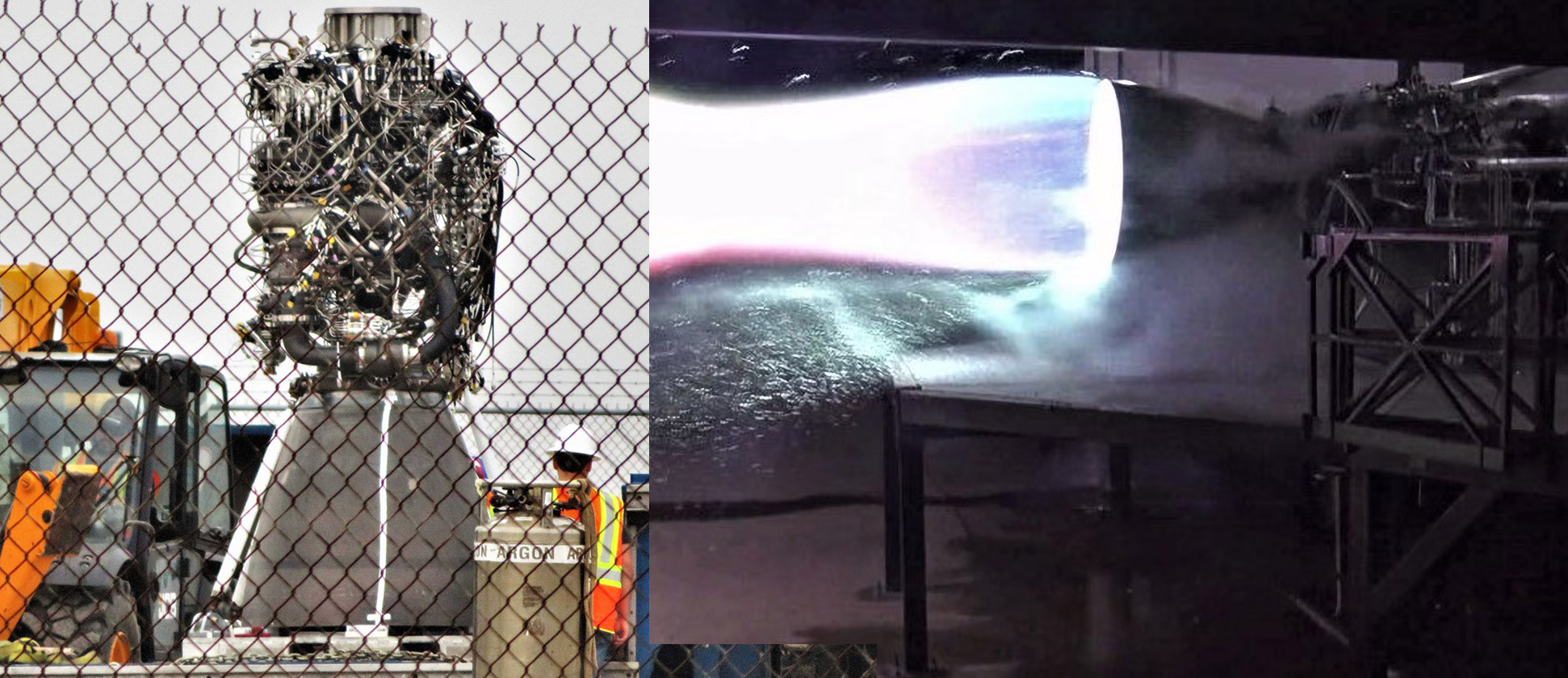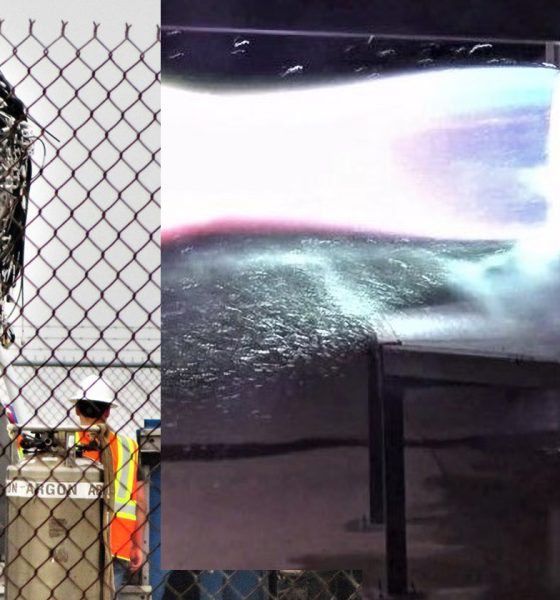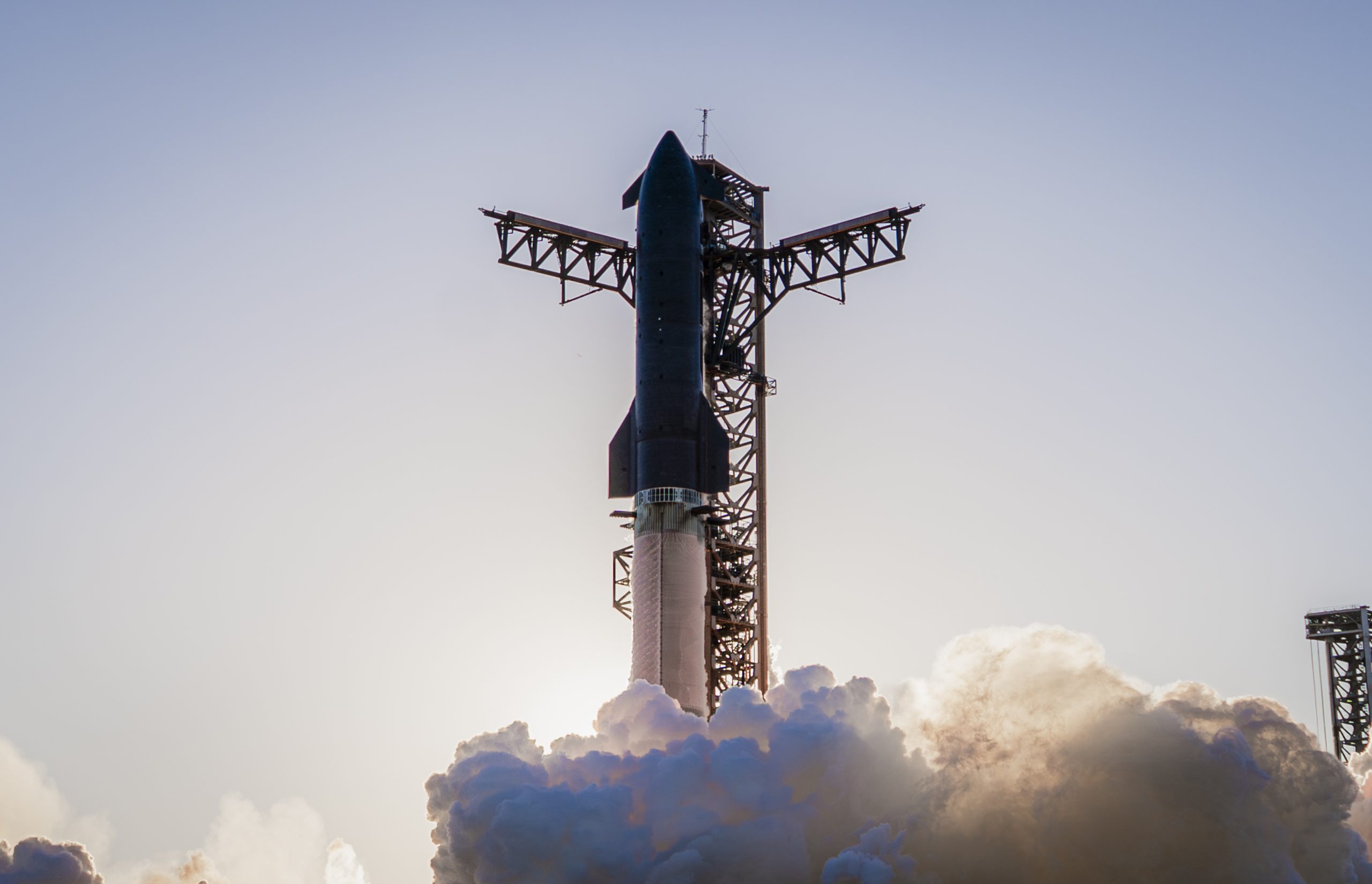

SpaceX
SpaceX begins static Starhopper tests as Raptor engine arrives on schedule
SpaceX has officially begun static ground testing of Starhopper, a full-scale pathfinder Starship prototype meant to support an early series of Raptor-powered hop tests at SpaceX’s South Texas launch site. Simultaneously, the second completed Raptor engine arrived at the site on Monday, March 11th, confirming CEO Elon Musk’s March 8th tweets about the delivery.
While reasonably routine for any rocket test program, the first tanking test of Starhopper effectively marks the first time that SpaceX has begun tests with a more or less fully integrated Starship (previously BFS). Likely performed with liquid nitrogen instead of liquid oxygen/methane, the first few tanking tests will be used to determine the quality of the prototype’s stainless steel tanks – built en
In November 2016, SpaceX began propellant-loading tests of its first finished full-scale Starship (then Big Falcon Spaceship) hardware, a massive carbon composite liquid oxygen tank stretching 12 m (~40 ft) in diameter. Over the course of 2017, SpaceX transitioned from liquid nitrogen to liquid oxygen and ultimately conducted one final burst-test in which the composite tank was pressurized until it exploded, ending full-scale BFR composite testing with a bang. Within 6-12 months, Musk had come to the conclusion that a stainless steel BFR would ultimately be a superior path forward for the rocket and spaceship and attempted (apparently successfully) to get his team of R&D engineers on board with such a radical change so late in the development phase.
Despite the fact that that radical design departure may have occurred as few as 6-8 months ago, SpaceX engineers and technicians have accomplished an extremely rapid development program that will – in part – culminate in the hopefully successful hop testing of Starhopper, the first Starship prototype. While more of a rough testbed than an actual representation of the hardware and structures that will be required for a reusable orbital-class Starship, Starhopper has at least acted as a crash course (either technically or organizationally) on fabricating and assembling stainless steel aerospace structures, a material largely foreign to SpaceX flight hardware prior to late 2018.
Although the early vehicle was less than encouraging, as was the demise of its nosecone as a consequence of improper planning and/or bad workmanship, Starhopper as it now stands might actually be flightworthy in the context of suborbital, subsonic hop tests. Powered by the same or similar Raptors that would power orbital prototypes, Starhopper’s hop tests would optimally provide a wealth of experience and engineering data for both building 9 meter/30 foot-diameter stainless steel rocket sections and operating full-scale Raptor engine(s) in actual flight configurations. Extensive testing with Raptor will help to ensure that the fit and finish of the new engine’s flight-grade avionics and hardware are up to the challenge of safe, reliable, and gentle operations for a nominally crew-rated launch vehicle and spacecraft.
Around two days after Starhopper was briskly transported from its build site to SpaceX’s brand new launch facility, local Twitter account @SPadre (short for South Padre Island) posted a video of tanking test that occurred on March 11th, capturing the sound of venting as the liquid involved turned to gas inside its propellant tank(s). The fact alone that the person behind the camera was allowed to be where they were during the test all but guarantees that this first test was performed with an inert liquid, most likely liquid nitrogen given a massive delivery that occurred the day before (March 10th). In no conceivable world would SpaceX or local law enforcement willingly allow for Starhopper to be loaded – for the first time ever – with even a partial load of liquid methane or liquid oxygen with bystanders barely a few hundred feet distant.

When SpaceX gets to the point that they are confident enough in the structural integrity of Starhopper to begin wet dress rehearsals and tests with actual propellant, it’s a safe bet that the company will cooperate with local law enforcement to block off the lone access road to a distance of at least 1-2 miles, if not more. It’s unclear if local homeowners and residents will be forced to vacate the adjacent Boca Chica Village during testing, but chances are good that nobody will be within several thousand feet of Starhopper when those propellant loading tests begin, let alone actual static fire activity once Raptor(s) are installed.
According to an official SpaceX statement on the progress, propellant load tests and static fires could begin “in the days ahead”, although the spokesperson was under the impression that those tests – as well as initial hop tests – “[would] not be visible from offsite”. Unless SpaceX plans to draw a keep-out zone with a radius of multiple miles, interested observers will almost certainly be able to get close enough to at least catch a glimpse of Starhopper, but the statement still offers an idea of just how focused the company will be on safety during these early tests.
Check out Teslarati’s Marketplace! We offer Tesla accessories, including for the Tesla Cybertruck and Tesla Model 3.

Elon Musk
SpaceX maintains unbelievable Starship target despite Booster 18 incident
It appears that it will take more than an anomaly to stop SpaceX’s march towards Starship V3’s refinement.

SpaceX recently shared an incredibly ambitious and bold update about Starship V3’s 12th test flight.
Despite the anomaly that damaged Booster 18, SpaceX maintained that it was still following its plans for the upgraded spacecraft and booster for the coming months. Needless to say, it appears that it will take more than an anomaly to stop SpaceX’s march towards Starship V3’s refinement.
Starship V3 is still on a rapid development path
SpaceX’s update was posted through the private space company’s official account on social media platform X. As per the company, “the Starbase team plans to have the next Super Heavy booster stacked in December, which puts it on pace with the test schedule planned for the first Starship V3 vehicle and associated ground systems.”
SpaceX then announced that Starship V3’s maiden flight is still expected to happen early next year. “Starship’s twelfth flight test remains targeted for the first quarter of 2026,” the company wrote in its post on X.
Elon Musk mentioned a similar timeline on X earlier this year. In the lead up to Starshp Flight 11, which proved flawless, Musk stated that “Starship V3 is a massive upgrade from the current V2 and should be through production and testing by end of year, with heavy flight activity next year.” Musk has also mentioned that Starship V3 should be good enough to use for initial Mars missions.
Booster 18 failure not slowing Starship V3’s schedule
SpaceX’s bold update came after Booster 18 experienced a major anomaly during gas system pressure testing at SpaceX’s Massey facility in Starbase, Texas. SpaceX confirmed in a post on X that no propellant was loaded, no engines were installed, and personnel were positioned at a safe distance when the booster’s lower section crumpled, resulting in no injuries.
Still, livestream footage showed significant damage around the liquid oxygen tank area of Booster 18, leading observers to speculate that the booster was a total loss. Booster 18 was among the earliest vehicles in the Starship V3 series, making the failure notable. Despite the setback, Starship V3’s development plans appear unchanged, with SpaceX pushing ahead of its Q1 2026 test flight target.
Elon Musk
SpaceX issues statement on Starship V3 Booster 18 anomaly
The incident unfolded during gas-system pressure testing at the company’s Massey facility in Starbase, Texas.

SpaceX has issued an initial statement about Starship Booster 18’s anomaly early Friday. The incident unfolded during gas-system pressure testing at the company’s Massey facility in Starbase, Texas.
SpaceX’s initial comment
As per SpaceX in a post on its official account on social media platform X, Booster 18 was undergoing gas system pressure tests when the anomaly happened. Despite the nature of the incident, the company emphasized that no propellant was loaded, no engines were installed, and personnel were kept at a safe distance from the booster, resulting in zero injuries.
“Booster 18 suffered an anomaly during gas system pressure testing that we were conducting in advance of structural proof testing. No propellant was on the vehicle, and engines were not yet installed. The teams need time to investigate before we are confident of the cause. No one was injured as we maintain a safe distance for personnel during this type of testing. The site remains clear and we are working plans to safely reenter the site,” SpaceX wrote in its post on X.
Incident and aftermath
Livestream footage from LabPadre showed Booster 18’s lower half crumpling around the liquid oxygen tank area at approximately 4:04 a.m. CT. Subsequent images posted by on-site observers revealed extensive deformation across the booster’s lower structure. Needless to say, spaceflight observers have noted that Booster 18 would likely be a complete loss due to its anomaly.
Booster 18 had rolled out only a day earlier and was one of the first vehicles in the Starship V3 program. The V3 series incorporates structural reinforcements and reliability upgrades intended to prepare Starship for rapid-reuse testing and eventual tower-catch operations. Elon Musk has been optimistic about Starship V3, previously noting on X that the spacecraft might be able to complete initial missions to Mars.
Elon Musk
SpaceX Starship Version 3 booster crumples in early testing
Photos of the incident’s aftermath suggest that Booster 18 will likely be retired.

SpaceX’s new Starship first-stage booster, Booster 18, suffered major damage early Friday during its first round of testing in Starbase, Texas, just one day after rolling out of the factory.
Based on videos of the incident, the lower section of the rocket booster appeared to crumple during a pressurization test. Photos of the incident’s aftermath suggest that Booster 18 will likely be retired.
Booster test failure
SpaceX began structural and propellant-system verification tests on Booster 18 Thursday night at the Massey’s Test Site, only a few miles from Starbase’s production facilities, as noted in an Ars Technica report. At 4:04 a.m. CT on Friday, a livestream from LabPadre Space captured the booster’s lower half experiencing a sudden destructive event around its liquid oxygen tank section. Post-incident images, shared on X by @StarshipGazer, showed notable deformation in the booster’s lower structure.
Neither SpaceX nor Elon Musk had commented as of Friday morning, but the vehicle’s condition suggests it is likely a complete loss. This is quite unfortunate, as Booster 18 is already part of the Starship V3 program, which includes design fixes and upgrades intended to improve reliability. While SpaceX maintains a rather rapid Starship production line in Starbase, Booster 18 was generally expected to validate the improvements implemented in the V3 program.
Tight deadlines
SpaceX needs Starship boosters and upper stages to begin demonstrating rapid reuse, tower catches, and early operational Starlink missions over the next two years. More critically, NASA’s Artemis program depends on an on-orbit refueling test in the second half of 2026, a requirement for the vehicle’s expected crewed lunar landing around 2028.
While SpaceX is known for diagnosing failures quickly and returning to testing at unmatched speed, losing the newest-generation booster at the very start of its campaign highlights the immense challenge involved in scaling Starship into a reliable, high-cadence launch system. SpaceX, however, is known for getting things done quickly, so it would not be a surprise if the company manages to figure out what happened to Booster 18 in the near future.








